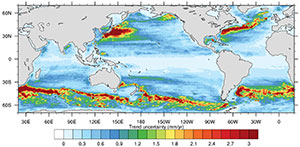PIRATE: Probabilistic InteRpretation of Altimeter & in-siTu obsErvations
Author:
Thierry Penduff - (IGE)
Co-Investigator(s):
Sally Close (IGE)
Beatriz Ixetl Garcia Gomez (IGE)
Bernard Barnier (IGE)
Jean-Marc Molines (IGE)
Benoît Meyssignac (LEGOS)
Gauillaume Maze (LOPS)
Sabrina Speich (EMS-LMD)
Laurent Terray (CERFACS)
Collaborator(s):
Bablu Sinha (NOC, Southampton)
Alex Megann (NOC, Southampton)
Brian Arbic (Univ. Michigan)
Abstract:

Altimeter and other satellite/in-situ oceanic observations have provided essential information over the last decades for improving our knowledge of the global oceanic state, variability, and long-term changes. Careful investigations of these observations jointly with state-of-the-art numerical simulations have also helped a lot for interpreting these changes and their underlying mechanisms, as well as for improving model simulations. Some of these joint observational/numerical investigations, such as the CHAOCEAN OSTST project or the OCCIPUT ANR project, have demonstrated in particular that the simulated (and very probably the observed) evolution of the ocean in the turbulent regime has a stochastic character, even over long (interannual-to-multidecadal) periods. In other words, the actual atmospheric evolution may force a variety (an ensemble) of long-term oceanic trajectories, because the eddying ocean is a atmospherically-modulated chaotic system that is sensitive to small perturbations. This means that the most accurate collection of satellite/in-situ observations can only describe the evolution that the real ocean has randomly picked among a barely-known ensemble of possible evolutions.
The proposing team has recently completed the first ensemble simulations of the oceanic evolution over the last 5 decades in the eddying regime; this global 50-member experiment represents this ensemble of possible oceanic evolutions driven by the observed (reanalyzed) atmospheric evolution. We propose to take advantage of these model data, of Jason-2 and hydrographic observations, and of ensemble synthetic versions of these observations to investigate several observational implications of this inherent, nonlinearly-induced oceanic uncertainty.
The PIRATE collaborative project is focused on the imprints of the oceanic chaos and of its modulation by the atmosphere on individual and integrated observations (SLA, SST, Heat Content, MOC, etc), and on the representativeness of these observations for the monitoring (and reanalysis) of the variability and long-term changes in the ocean. In particular we propose to
- identify the observations, locations and timescales that are most affected by the low-frequency chaos;
- to assess whether part of its imprint on observations may be attenuated in observational data;
- to investigate the respective roles of the atmosphere and of the oceanic chaos in the recent global warming hiatus;
- to define adequate metrics to accurately measure the control exerted by the atmospheric on the oceanic chaos; and
- to evaluate the impact of this inherent uncertainty on the observed/simulated estimates of energy and mass budgets of the climate system.
These investigations will provide the community (including operational oceanographers in charge of reanalysing or predicting the oceanic evolution) with quantitative estimates of the chaos-related uncertainties (e.g. error bars and richer statistical information) associated with individual and integrated observational information, and of the observed part of observed signals that may be explained by atmospheric causes. Regions (of the global ocean, of the spatiotemporal spectrum) and observations that are less impacted by the chaotic ocean variability will be identified, hence potentially guiding the design of observation systems that are most representative of atmospheric influences.
